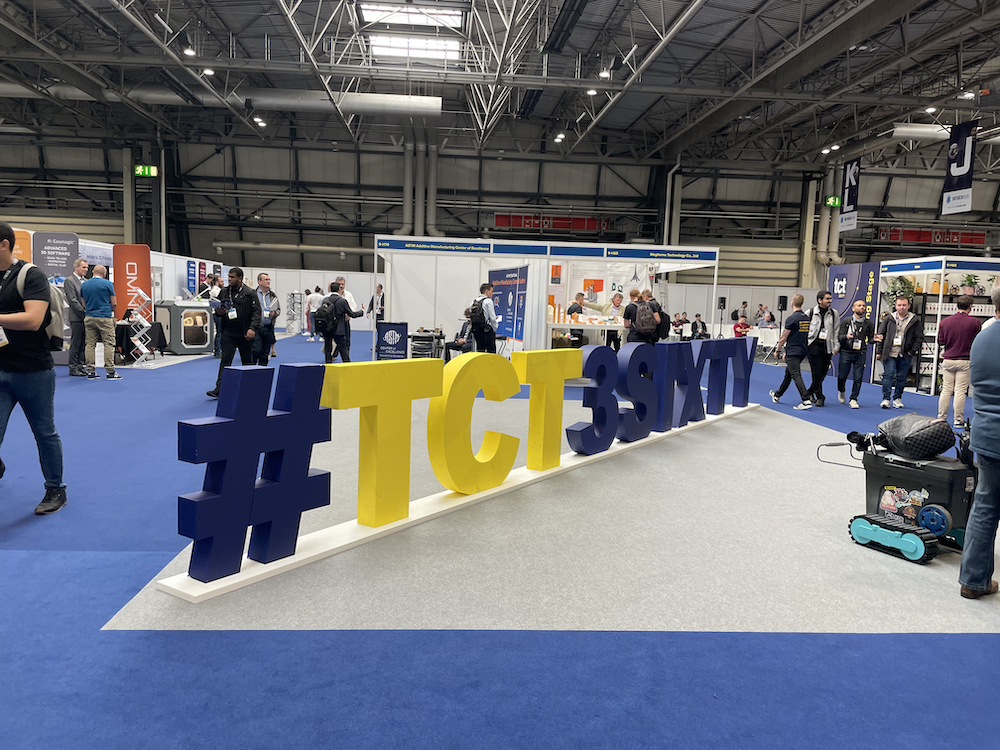

For 30 years, the TCT Group has curated the leading UK event in the drive to increase awareness and adoption of additive manufacturing and 3D printing technology.
The event’s origins stretch back to 1992 when a newsletter grew to become Rapid News: The Magazine of the Rapid Prototyping and Tooling Industry. Just four years later, they hosted their first live event, the Time-Compression Technologies ’96 Conference, and in 1997 they adopted the name Time-Compression Technologies – TCT for short!
Fast-forward to 2011, and the UK event found a home at the NEC, Birmingham. Today, TCT 3Sixty is the flagship event of the TCT Group, a leading authority in additive manufacturing, 3D printing, design and engineering technology across the globe.
Not having visited TCT 3Sixty for several years, the progress that has been made in additive manufacturing in all its forms is astonishing. Where the industry was dominated by hobby 3D printers, the industrial aspect of this sector has continued to expand and now offers a clear path to the future of manufacturing across all industries and sectors. From clothing to houses, this technology is transforming how we think about manufacturing.
All of the leading manufacturers of AM machines and allied technologies had a presence at the event, including well-known brands such as Stratasys, Photocentric and Matsuura whose stand was very busy as they showed the entire AM workflow indicating how a complete AM manufacturing is now possible.
“We are accelerating into the Additive Manufacturing 2.0 era, in which we see global manufacturing leaders move beyond prototyping to fully embrace the agility that 3D printing brings to the entire manufacturing value chain,” said Stratasys CEO Dr. Yoav Zeif. “The disruptions we are seeing today on both the supply and demand side of global supply chains are a clear sign that the status quo isn’t working. Additive manufacturing gives companies the total flexibility to decide when, where, and how to produce parts. That’s why we’re committed to being the complete provider of polymer 3D printing solutions for our world-class customer base.”
Scanning systems also had a major presence at this year’s event. The T3DMC (3D Measuring Company) showed their latest scanning system, the SIMSCAN, and also the KSCAN Magic – both of which could be game-changers in this part of the AM workflow.
New materials were also being showcased with a particular focus on sustainability. The 100% reusable powder from the Belgian company Materialise. The product they call Bluesint. TCT Magazine reported: “Bluesint works by controlling two lasers within the printer, one for sintering the powder, and a second to keep the powder above a certain temperature. This prevents it from cooling down between two layers and as a result, eliminates the dreaded shrinking process. This breakthrough, Materialise claims, delivers 100% recycled parts featuring similar mechanical and visual properties to those printed with fresh powder.”
Metal AM also had a significant presence at TCT 3Sixty. TRUMPF showed their impressive Laser Powder Bed Fusion systems at one end of the AM spectrum, with Xact Metal showing their much more compact XM200C, which is ideal for short runs and metal prototyping. And if metal AM is your focus, then then the thyssenkrupp Materials UK was the stand to ensure you visited.
Outside of industrial AM production, the smaller machine market has also expanded. On show was the new J55 from Stratasys that has PANTONE validated colours, textures, and transparency at a cost of $99,000 – around a third of the cost of enterprise-class PolyJet systems.
Formlabs’ SLA machine (the Fuse 1) made an appearance at the show. Formlabs CEO and co-founder Max Lobovsky said: “SLS 3D printing shouldn’t be solely for those with big budgets, it needs to be accessible so all companies —from start-up to big manufacturer — can benefit from the design freedom and high productivity SLS 3D printing provides.”
Other well-known brands in the small form factor market, including Ultimaker and Formlabs showed just how far the technology seen in AM machines for industrial use has now filtered down to the desktop AM marketplace.
https://api.soundcloud.com/tracks/1285083877
American space agency prepares for testing of Boeing's Starliner, to ensure it has two space…
As UK and Europe develop closer military ties, European Commission says it will invest €1.3…
Zuckerberg seeks to revive Facebook's original spirit, as Meta launches Facebook Friends tab, so users…
Notable development for Meta, after appeal against 2021 WhatsApp privacy fine is backed by advisor…
First sign of shake-up under new CEO Lip-Bu Tan? Three Intel board members confirm they…
Trump's nominee for SEC Chairman, Paul Atkins, has pledged a “rational, coherent, and principled approach”…